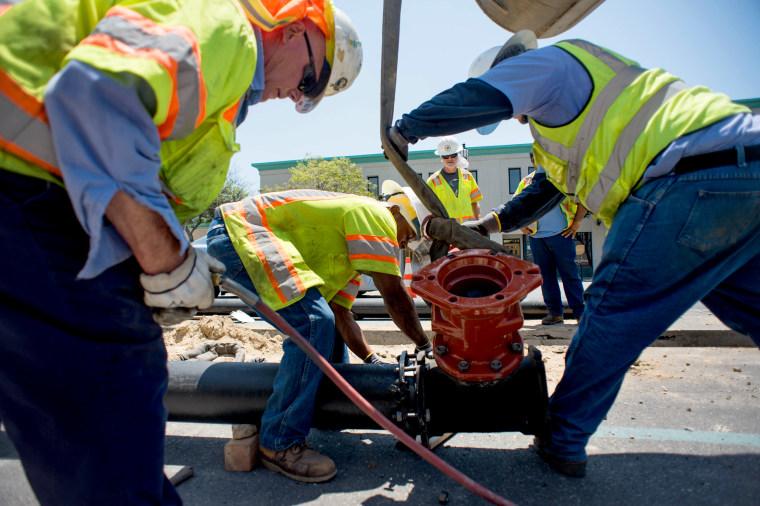The country’s 32 million outside workers — electricians, landscapers, farmworkers, roofers, oil riggers — are projected to quadruple their heat exposure by 2065, putting at risk $55 billion in income as they face a difficult choice between their health and their jobs, according to a study released Tuesday by the Union of Concerned Scientists.
The study comes as this summer’s relentless heat waves have raised concerns across labor groups about the health costs of climate change. From 1992 to 2017, heat stress injuries killed 815 U.S. workers and seriously injured more than 70,000, according to the Occupational Safety and Health Administration.
All workers are covered by OSHA’s “general clause” protection, which requires companies to keep workplaces “free from recognized hazards,” including heat. But only two states, California and Washington, have specific heat illness prevention standards that include access to drinking water, shade and minimum cool-down rest periods. In Texas, where the average outside worker risks losing $3,500 in lost earnings to extreme heat by midcentury, there is no state right to a rest break.
Claudia Golinelli, an undocumented immigrant from El Salvador who works as a contract electrician in Garland, Texas, told NBC News that rest breaks are the only way she keeps herself from fainting at work during the heat. She said that while temperatures outside might be in the 90s, in some of the attics or upper levels of a building, temperatures can be more than 100 degrees.
“Although I have water with me, I can’t always drink it because I have to finish the work,” she said. Golinelli, who makes $20 an hour, said she has no choice but to work during hot days, relying on water and sun-protective shirts. “I have to clothe my kids and my kids have to eat,” she said.
Emily Timm, co-executive director of the Texas labor advocacy group Workers Defense Project, told NBC News that because heat waves are so common in Texas, construction sites rarely shut down.
“You’re expected to still show up and do the job and if you choose not to, you lose pay,” she said.
The organization lobbied to pass policies in Dallas and Austin requiring paid rest breaks for construction workers. It also helped to pass paid sick-day policies for all employees in Austin and San Antonio. But a Texas state bill passed this year would ban any local policy that would require employers to provide paid sick leave, rest breaks or stable work schedules. The bill has yet to be signed by Gov. Greg Abbott, a Republican.
In the most recent calculation of the economic impact of heat since a 2018 government report, the Union of Concerned Scientist study found 7.6 million construction and extraction workers would risk an average of $1,900 in annual income by midcentury as a result of extreme heat if no action is taken on climate change. About a quarter of these workers would risk losing $3,000 or more a year.
The group analyzed county-level projections of dangerously hot days where the combined heat and humidity reached 100 to 108 degrees Fahrenheit, at which the Centers for Disease Control and Prevention recommends employers reduce work schedules. It also included workdays lost when temperatures exceed 108 degrees F, at which the CDC recommends employers stop work entirely. By midcentury, without any reduction in global emissions, extreme heat would risk as many as 54 workdays per year, it found.
“During Covid there were so many people who were deemed essential workers and critically important but not being treated as such and they had to choose between their health and paycheck,” said Rachel Licker, a senior climate scientist with the Union of Concerned Scientists and co-author of the study. “It felt similar to what we’ve seen with workers in the face of climate change unless things really change.”
As the heat hammers businesses, labor advocates and lawmakers now worry about how extreme heat events will slow the economy.
“With the increasing prevalence of extreme weather conditions as well as employers who neglect to invest in their workplaces, the risk this danger poses for our workers, communities, and the economy is at a pressure point,” U.S. Sens. Alex Padilla of California and Sherrod Brown of Ohio, both Democrats, wrote in a letter this month to OSHA urging the agency to create a federal heat standard to protect workers. “Inaction exacerbates the risks to our economy. Workers and businesses will suffer the loss of wages and productivity.”
Amanda McClure, a spokesperson for the U.S. Department of Labor, told NBC News in an emailed statement that the agency continues to explore how to decrease the risk of heat exposure and illness.
“Heat illness prevention is one of the agency’s top priorities, and we share the concerns of occupational heat exposure to workers,” she said.
